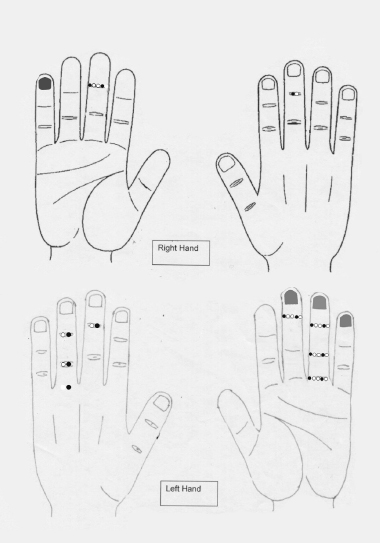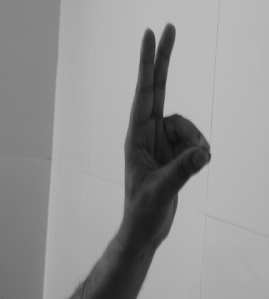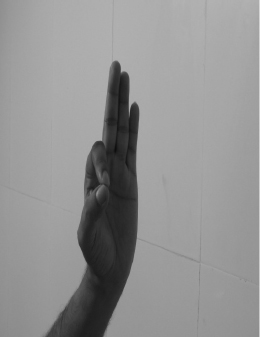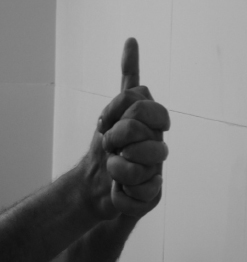Dancing with Life (16 page)
Authors: Jamuna Rangachari

- Brain points: The brain is an important auricular point and should be used in almost every ear prescription. The brain controls everything – all bodily systems and parts – and thus controls pain perception, movement, and the proper functioning of all organs.
- Vitality point: Putting pressure on this point improves immune system disorders.
- Zero point: Zero point is one of the most recognized auricular points and is used in the treatment of many ailments. Zero point is known to have a powerful influence in treating various conditions including pain, sedation, addiction treatment and inflammation.
- Lumbo-sacral points: Pressure on this point helps improve the spine’s strength.
All the above are extremely effective in MS and one can even do this by taping seeds as small as that of mustard or fenugreek on the relevant points.
M
AGNET
AND
C
OLOUR
T
HERAPY
I am aware of the fact that MS patients find it tiring to travel, and when they have to do it regularly for taking acupuncture treatment, it might be difficult. So, here I recommend a simple therapy which combines magnet and colour therapy. Moreover, this therapy is also based on the same principles as that of acupuncture.
The institution that conducts this training is called the Acupressure Research, Training and Treatment Sansthan and is located in Allahabad. Founded in 2003, they have undertaken research to treat a vast number of diseases (including intractable diseases) such as cancer, AIDS, MS, kidney failure, tuberculosis, spinal disorders and so on.
I heard about one gentleman whose wife’s vision and mobility had got impaired due to MS who was taking treatment here. She had indeed become better within six months of taking treatment and goes there regularly now.
Dr Ajay Misra tells you how you can use colour therapy for MS:
- Sky blue below the nail – left hand front side – small finger
- Orange below the nail – left hand front side – ring finger
- Pink below the nail – left hand front side – middle finger
- Violet below the nail – right hand front side – small finger
As far as magnets are concerned, while acupuncture uses needles to balance the flow of energy, in magnet therapy, small magnets are tied at specific points.
They should be put on the points marked in the chart. Each magnet has yellow colour on one side and white on the other. In the dots marked black, the yellow should be visible on top of the finger means yellow magnet should be visible after affixing the paper (medical) tape and in the dots marked white, white should be visible on top of the finger means white magnet should be visible after affixing the paper (medical) tape.
This has a similar therapeutic effect like acupuncture. When magnets are not available, these points can be energized using fenugreek seeds.
I have been practicing this on myself too, mostly in the night while sleeping. This has made me feel slightly better and more energetic.

O
IL
P
ULLING
BY
K
ETAN
S
HAH
Oil pulling therapy should ideally be done early morning on an empty stomach. Take one tablespoon of oil (preferably sesame oil) and swish/rinse it gently in your mouth for twenty minutes.
Ensure that the oil reaches all corners of the mouth. Do not vigorously gargle. As you continue swishing, the oil, from being clear and thick, will become thinner and whitish in color. Swishing activates enzymes that help draw out the toxins in your body. Do not swallow the oil but spit it out and then brush your teeth. I have been doing this for four years everyday and definitely feel more energetic after doing it.
S
WASIO
T
ECHNIQUE
BY
K
ETAN
S
HAH
Swasio is a Japanese healing technique and consists of the following steps:
- Stand firmly on the ground with the legs and torso straight. Your arms should be free, and it is better that you do this with bare feet
- Lift your arms up and breathe in
- Bring your arms down and breathe out
- Do it at slow speed ten times, then moderate speed and then at quick speed
- Increase the number of times to fifty and then hundred.
This strengthens the lungs, blood circulation, and bowel movement and reduces fat. This is extremely relevant for those of us with neurological problems, as it strengthens the nervous system.
M
UDRAS
AND
M
EDITATION
BY
B. K. C
HANDRASEKHAR
Mudras are something we often hear about but do not take very seriously. I met and interviewed B.K. Chandrasekar and also learnt from him the mudras that could be helpful for MS. I practice these mudras regularly and they have certainly made me feel better.
1. Prana Mudra:

Procedure:
In Prana mudra we bring the tip of the thumb, the tip of the ring finger and the tip of the little finger together. Put a little pressure on the joined tips. Chant OM or AUM as this generates good vibrations. Ideally, this should be performed for five minutes on an empty stomach.
Benefits
: Increases vitality and keeps you feeling energetic throughout the day
.
2. Gyan Mudra:

Procedure:
Join the tips of the index finger and thumb. Maintain this for at least fifteen minutes. You can even do this while walking.
Benefits:
Mental power becomes stronger and disorders of the nervous system are rectified. Moreover, degeneration of the retina and optic atrophy is also rectified.
3. Shivling Mudra

Procedure:
Step 1
: Sit straight upon the floor or on a chair; you can also be in the standing position. Your arms should be parallel to your sides and bent upwards at the elbows, with your hands clenched in fists at approximately shoulder height if you are in standing position.
Step 2
: Now inhale a single deep breath by visualizing the colour red. Through this process, the mind power is directed into bones and muscles.
Step 3
: Hold the breath inside, clinch your fist, make your muscles tight and imagine your muscles glowing, radiating a bright red colour. Try to pull your anus upward.
Step 4
: Now breathe out faster by releasing muscles and opening your fist simultaneously. Put your hands down if you are standing up. Hold this pose for at least one minute.
Benefits
: Through this mudra, the absorption of calcium in bones and iron in blood takes place quickly.
Recommended meditation:
Apart from the mudras, Dr Chandrasekhar also recommended some meditation techniques that can be done every day to combat stress. The procedure of meditation is also given below. I could relate to it as this was similar to what my mentor, Promila Gurtu had earlier taught me.
Procedure:
Sit comfortably and just concentrate on some steps given below. Do not fight thoughts that may enter your mind. If you just let them be for some time, thoughts will vanish on their own.
As a first step, visualize the top of your head that is the crown chakra.
- Visualize sparkling red rays entering through your crown chakra and going all the way down to your root chakra that is at the end of the spine (tailbone).
- Then visualize the indigo colour on top. Now visualize the bright and vibrant indigo coloured rays going through your crown chakra.
- Visualize that all your brain cells have become activated and are in a state of bliss.
It is not that we need to keep obsessing over what to do all the time but we can certainly incorporate some or most of the above techniques, as these are easily doable and have no negative effect. Essentially, it is all about incorporating whatever works in one’s routine and thus making ourselves stronger.
I
N THE PROCESS OF HANDLING
MS, I
HAVE LEARNT
many life lessons that I would like to share:
1. Connect with the world
It is extremely important for all of us to remain connected with the world and not be isolated. We need to always remember that we control the ailment and that the ailment does not control us. This is the only way we can have control over our lives.
I recommend attending all social events, not out of compulsion, but to get used to being with others, whatever our physical condition. This will make us more confident. However, we have to connect with others on our own terms and be happy about it. We should be ourselves while connecting with others, and not just pretend to connect.
2. Help your nerve growth factor function
Nerve growth factor (NGF) is a small secreted protein that is important for the growth, maintenance and survival of certain target neurons (nerve cells). It also functions as a signalling molecule.
Stress and/or anxiety is usually a precipitating factor that leads to reduced secretion of NGF leading to impaired cognitive functioning. Pranayam and breathing exercises help, as do feelings of being cared for. To make it function better, all that we need to do is to remain positive and grateful for the little mercies that are bestowed on us.
3. Follow a regular fitness routine
We are aware of the benefits of regular exercise to promote general health. This is valid for everyone, and even more so for people with a health challenge like MS.
Doing all that we were doing earlier may not be possible but we can always change the routine and modify it to suit our new level of fitness. In other words, we must never stop having a fitness routine.
4. Diet management
One’s diet is important to maintain good health. Even though nothing is clearly known about the ideal diet for MS, we should try and ensure that we have a reasonably healthy diet always.
5. Come to terms with uncertainty
We all need to come to terms with the fact that there are no guarantees in life. Despite taking many precautions, we may suffer from an accident suddenly, our business may fail due to a recession in the market, houses may crumble and in the area of health, a simple infection could lead to a major ailment.